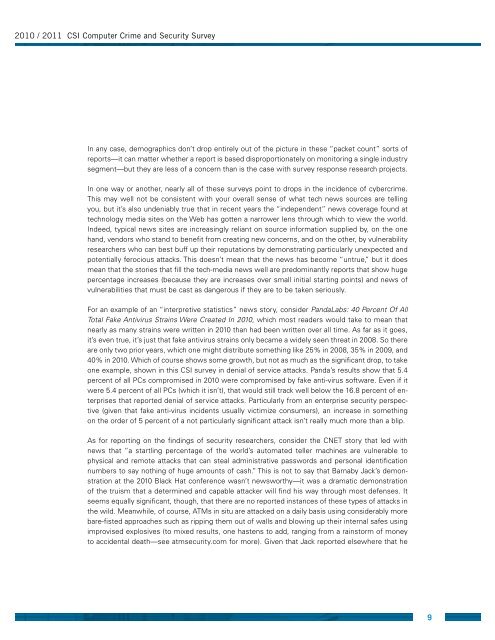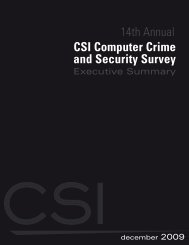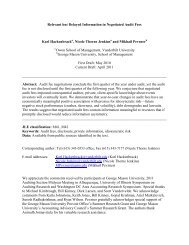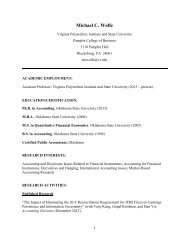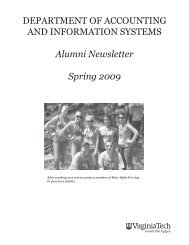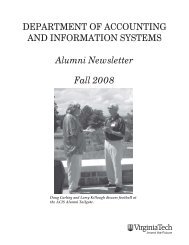2010/2011 Computer CrIme and SeCurIty Survey - Gatton College ...
2010/2011 Computer CrIme and SeCurIty Survey - Gatton College ...
2010/2011 Computer CrIme and SeCurIty Survey - Gatton College ...
You also want an ePaper? Increase the reach of your titles
YUMPU automatically turns print PDFs into web optimized ePapers that Google loves.
<strong>2010</strong> / <strong>2011</strong> CSI <strong>Computer</strong> Crime <strong>and</strong> Security <strong>Survey</strong>In any case, demographics don’t drop entirely out of the picture in these “packet count” sorts ofreports—it can matter whether a report is based disproportionately on monitoring a single industrysegment—but they are less of a concern than is the case with survey response research projects.In one way or another, nearly all of these surveys point to drops in the incidence of cybercrime.This may well not be consistent with your overall sense of what tech news sources are tellingyou, but it’s also undeniably true that in recent years the “independent” news coverage found attechnology media sites on the Web has gotten a narrower lens through which to view the world.Indeed, typical news sites are increasingly reliant on source information supplied by, on the oneh<strong>and</strong>, vendors who st<strong>and</strong> to benefit from creating new concerns, <strong>and</strong> on the other, by vulnerabilityresearchers who can best buff up their reputations by demonstrating particularly unexpected <strong>and</strong>potentially ferocious attacks. This doesn’t mean that the news has become “untrue,” but it doesmean that the stories that fill the tech-media news well are predominantly reports that show hugepercentage increases (because they are increases over small initial starting points) <strong>and</strong> news ofvulnerabilities that must be cast as dangerous if they are to be taken seriously.For an example of an “interpretive statistics” news story, consider P<strong>and</strong>aLabs: 40 Percent Of AllTotal Fake Antivirus Strains Were Created In <strong>2010</strong>, which most readers would take to mean thatnearly as many strains were written in <strong>2010</strong> than had been written over all time. As far as it goes,it’s even true, it’s just that fake antivirus strains only became a widely seen threat in 2008. So thereare only two prior years, which one might distribute something like 25% in 2008, 35% in 2009, <strong>and</strong>40% in <strong>2010</strong>. Which of course shows some growth, but not as much as the significant drop, to takeone example, shown in this CSI survey in denial of service attacks. P<strong>and</strong>a’s results show that 5.4percent of all PCs compromised in <strong>2010</strong> were compromised by fake anti-virus software. Even if itwere 5.4 percent of all PCs (which it isn’t), that would still track well below the 16.8 percent of enterprisesthat reported denial of service attacks. Particularly from an enterprise security perspective(given that fake anti-virus incidents usually victimize consumers), an increase in somethingon the order of 5 percent of a not particularly significant attack isn’t really much more than a blip.As for reporting on the findings of security researchers, consider the CNET story that led withnews that “a startling percentage of the world’s automated teller machines are vulnerable tophysical <strong>and</strong> remote attacks that can steal administrative passwords <strong>and</strong> personal identificationnumbers to say nothing of huge amounts of cash.” This is not to say that Barnaby Jack’s demonstrationat the <strong>2010</strong> Black Hat conference wasn’t newsworthy—it was a dramatic demonstrationof the truism that a determined <strong>and</strong> capable attacker will find his way through most defenses. Itseems equally significant, though, that there are no reported instances of these types of attacks inthe wild. Meanwhile, of course, ATMs in situ are attacked on a daily basis using considerably morebare-fisted approaches such as ripping them out of walls <strong>and</strong> blowing up their internal safes usingimprovised explosives (to mixed results, one hastens to add, ranging from a rainstorm of moneyto accidental death—see atmsecurity.com for more). Given that Jack reported elsewhere that he9


